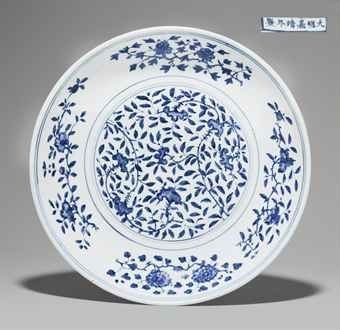An Unusual Large Blue and White Charger. Jiajing Six-Character Mark in underglaze blue in a line and of the Period (1522-1566)
An Unusual Large Blue and White Charger. Jiajing Six-Character Mark in underglaze blue in a line and of the Period (1522-1566). Photo: Christie's Images Ltd 2012
Stoutly potted with shallow rounded sides, the center of the interior is decorated with two leafy, scrolling stems bearing seven stylized flowers, possibly cockscomb, within line borders below sprays of peaches, chrysanthemums, pomegranate and peonies in the well. The exterior is decorated with three groupings of the 'The Three Friends,' pine, prunus and bamboo, withlingzhi and butterflies in between, and the reign mark is written within a rectangular cartouche below the rim. 17 3/8 in. (44 cm.) diam. Estimate $40,000 - $60,000
明嘉靖 青花纏枝花卉紋大盤 雙長方框六字楷書橫款
Provenance: Tsui Museum of Art, Hong Kong.
Notes: A dish of this same unusual pattern, and of comparable size (44.1 cm. diameter), also with the Jiajing reign mark written in a rectangular cartouche on the exterior, is in The National Palace Museum, Beijing, and illustrated in Zhongguo guojia bowuguan guan cang wenwu yanjiu congshu; ciqi juan; Ming dai, Shanghai, 2007, no. 80.
Two other larger dishes, of this design, with similarly written reign mark, are also published. One (52 cm. diameter), in the British Museum, is illustrated by J. Harrison-Hall in Ming Ceramics, London, 2001, p. 227, no. 9:27, where the author notes, p. 228, that the depiction of floral decoration in underglaze blue and white "reached its zenith" during the early fifteenth century, but is rare in the sixteenth century, when the earlier designs were copied for the court. While this dish is painted in fifteenth century style, the design did not exist in the fifteenth century. The other dish (50 cm. diameter) is illustrated by R. Krahl in Chinese Ceramics in the Topkapi Saray Museum, Istanbul, vol. II, London, 1986, p. 631, no. 926, where the author cites two other similar dishes, one in the Tokyo National Museum and one in the Idemitsu Art Museum. It is possible that the unusual flower depicted in the center of these dishes and the present dish is meant to represent cockscomb.
Christie's. Fine Chinese Ceramics and Works of Art Part II, 13 September 2012. New York, Rockefeller Plaza

/https%3A%2F%2Fprofilepics.canalblog.com%2Fprofilepics%2F1%2F0%2F100183.jpg)
/https%3A%2F%2Fstorage.canalblog.com%2F03%2F02%2F119589%2F96711876_o.jpg)
/https%3A%2F%2Fstorage.canalblog.com%2F11%2F31%2F119589%2F94773502_o.jpg)
/https%3A%2F%2Fstorage.canalblog.com%2F20%2F83%2F119589%2F94772815_o.jpg)
/https%3A%2F%2Fstorage.canalblog.com%2F26%2F72%2F119589%2F75604929_o.jpg)
/https%3A%2F%2Fstorage.canalblog.com%2F59%2F60%2F119589%2F26458628_o.jpg)



/image%2F1371349%2F20240512%2Fob_1b86bd_telechargement-12.jpg)
/image%2F1371349%2F20240512%2Fob_2e1ec7_telechargement-7.jpg)
/image%2F1371349%2F20240510%2Fob_25eb10_telechargement.jpg)
/image%2F1371349%2F20240416%2Fob_2a8420_437713933-1652609748842371-16764302136.jpg)